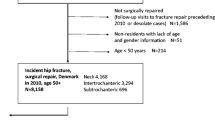Abstract
The challenge for healthcare systems around the world is delivering timely preventative strategies to subjects most likely to develop fragility fractures. The success or failure of national campaigns will be determined at local level, and many studies to date have found under-utilization of osteoporosis treatment strategies due to reduced public and healthcare professional awareness. An important link between the at-risk patients and their appropriate therapy is their identification and assessment. In the context of a medium sized secondary care provider, this study examined the efficiency of a nurse-led service for assessing women following distal forearm fracture, looking for additional risk factors for future fracture and also looking at uptake of the assessment programme among the target population. Two hundred and two women, median (range) age 69 (50–91) years presented with distal forearm fracture over a 9-month period. Fifty-four subjects did not participate in the study: they were significantly older than those who did (P<0.002). One hundred and forty-eight subjects underwent assessment of falls risk, future hip fracture risk and calcaneal ultrasound attenuation measurement: 107 attended for assessment at the hospital and 41 required a health professional to visit at their place of residence—the latter group were significantly older (P<0.0002). Of 148 subjects assessed, 76 (51%) had one or more risk factors for a fall: these subjects were significantly older (P<0.0002) and more likely to have required a home visit (P<0.002). Twenty-seven (18%) were considered at risk of a future hip fracture: again they were older and more likely to have required a home visit (P<0.0005). Ninety-one subjects (61%) had a calcaneal ultrasound attenuation T-score below –2.0, and were referred for bone densitometry: again, they were older (P<0.0002) and more likely to have required a home visit (P<0.05). Bone densitometry demonstrated osteoporosis in 47 (52%) of those with low attenuation, osteopenia in 31 and normal bone density in 13. Of 76 subjects deemed to be at risk of falls, 31 (41%) had osteoporosis demonstrated on bone densitometry and of those at risk of future hip fracture, 12 (44%) had osteoporosis. Only nine (22%) subjects who received home visits had no risk factors for falls or hip fracture and normal bone density, compared to 45 (42%) of those who attended hospital. This study has demonstrated that the efficiency of a program to assess additional risk of future fracture in a population who have already fractured may be influenced by where the assessment is delivered: it may be that the patients at greatest risk did not avail of the service.

Similar content being viewed by others
References
Royal College of Physicians (1999) Osteoporosis: clinical guidelines for prevention and treatment. Royal College of Physicians, London
Anonymous (2001) Osteoporosis prevention, diagnosis, and therapy. JAMA 285:785–795
Masud T, Jordan D, Hosking DJ (2001) Distal forearm fracture history in an older community-dwelling population: the Nottingham Community Osteoporosis (NOCOS) study. Age Ageing 30:255–258
Cuddihy MT, Gabriel SE, Crowson CS, Atkinson EJ, Tabini C, O'Fallon WM, Melton LJ (2002) Osteoporosis intervention following distal forearm fractures: a missed opportunity? Arch Int Med 162:421–426
Dargent-Molina P, Favier F, Grandjean H, Baudoin C, Schott AM, Hausherr E, Meunier PJ, Bréart G (1996) Fall-related factors and risk of hip fracture: the EPIDOS prospective study. Lancet 348:145–149
Close J, Ellis M, Hooper R, Glucksman E, Jackson S, Swift C (1999) Prevention of falls in the elderly Trial (PROFET): a randomised controlled trial. Lancet 353:93–97
Cummings SR, Nevitt MC, Browner WS, Stone K, Fox KM, Ensrud KE, Cauley J, Black D, Vogt TM (1995) Risk factors for hip fracture in white women. N Engl J Med 332:767–773
Cuddihy MT, Gabriel SE, Crowson CS, O'Fallon WM, Melton LJ (1999) Forearm fractures as predictors of subsequent osteoporotic fractures. Osteoporos Int 9:469–475
Chevalley T, Hoffmeyer P, Bonjour JP, Rizzoli R (2002) An osteoporosis clinical pathway for the medical management of patients with low-trauma fracture. Osteoporos Int; 13:450–455
Sahota O, Worley A, Hosking DJ (2000) An audit of current clinical practice in the management of osteoporosis in Nottingham. J Public Health Med 22:466–472
Mulherin DM, Smith JA, Price T (2000) Is patient anxiety about osteoporosis sufficient indication for measuring bone mineral density? Clin Exp Rheumatol 18:789
Kannus P, Parkkari J, Niemi S, Pasanen M, Palvanen M, Järvinen M, Vuori I (2000) Prevention of hip fracture in elderly people with use of a hip protector. N Engl J Med 343:1506–1513
Acknowledgements
The authors acknowledge the financial support of Procter and Gamble and Merck Sharpe and Dohme towards the purchase of a contact ultrasound bone analysis machine and the salary of the nurse employed to assess the patients.
Author information
Authors and Affiliations
Corresponding author
Rights and permissions
About this article
Cite this article
Mulherin, D., Williams, S., Smith, J.A. et al. Identification of risk factors for future fracture in patients following distal forearm fracture. Osteoporos Int 14, 757–760 (2003). https://doi.org/10.1007/s00198-003-1441-0
Received:
Accepted:
Published:
Issue Date:
DOI: https://doi.org/10.1007/s00198-003-1441-0




